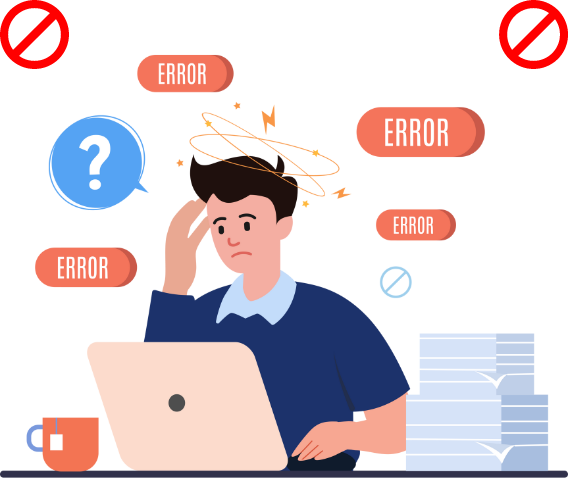Top 5 SEO Mistakes to Avoid
In this article, we will explain the importance of SEO and the most common top 5 SEO mistakes to avoid which can harm your website’s rankings. Search Engine Optimization (SEO) is a critical component of digital marketing, vital for:
- Visibility: Helps websites appear at the top of search engine results, crucial since most users don’t look past the first page.
- Cost Efficiency: SEO offers a more budget-friendly approach for long-term traffic compared to paid ads.
- User Experience: Optimized sites offer better speed and navigation, improving chances of customer retention and conversion.
- Competitive Advantage: A strong SEO strategy can distinguish your site from competitors in search engine rankings.
- Credibility: Higher search rankings can enhance a brand’s trustworthiness in the eyes of potential customers.
In short, SEO is the key to unlocking a brand’s online potential, driving organic traffic, and establishing a presence on the internet, which is now an essential part of doing business.

5 SEO Mistakes to Avoid
1. Ignoring the Importance of Mobile Optimization
Google’s mobile-first indexing refers to the practice of prioritizing the mobile version of a website for indexing and ranking. Due to the upsurge in mobile web usage, Google now primarily uses a site’s mobile content for search indexing. This approach emphasizes the necessity for mobile-friendly and responsive web design.
With mobile-first indexing, webmasters must ensure their mobile sites are user-friendly and contain the same high-quality content as the desktop version to maintain high search engine rankings.
Here are some tips to help ensure your site is mobile-friendly:
- Adopt Responsive Design: Make sure your site adapts to various screen sizes.
- Boost Loading Speed: Optimize images and minimize code for faster loads.
- Easy Navigation: Ensure menus are intuitive and user-friendly on mobile.
- Touch-Friendly Interfaces: Buttons and links should be easily clickable.
- Readable Text: Use legible, properly-sized fonts for mobile viewing.
- Mobile SEO: Align your site’s metadata and content with mobile behaviour.
2. Neglecting Quality Content
High-quality, informative content is essential for engaging users, building trust, and establishing authority online. It directly improves user experience, boosts SEO rankings, and drives organic traffic, thereby enhancing conversion rates. In the digital world, content that answers questions and provides value is the key to sustained success and visibility.
Keyword stuffing degrades content quality by compromising readability and relevance for the sake of higher search rankings. This practice can lead to penalties from search engines and also loss of user trust, as it prioritizes keywords over user value, ultimately hurting a site’s credibility and SEO efforts.
For engaging, SEO-friendly content, focus on your audience’s needs, drafting valuable, informative material. Incorporate keywords naturally and structure your work with clear headings and concise paragraphs. Use internal and external links wisely and optimize images with descriptive alt text.
Keep up with SEO trends and routinely refresh content to maintain relevance and interest. This approach balances user engagement with SEO efficacy.

3. Overlooking Website Speed and Performance
Slow-loading webpages significantly contribute to user abandonment, with a 40% bounce rate seen if load time exceeds three seconds. This immediate loss has serious implications on user engagement, satisfaction, and SEO, as speed is a key ranking factor. Thus, businesses and web developers prioritize webpage speed optimization, it is important to stress the importance of quick load times in maintaining an effective online presence.
To boost website speed, utilize tools like Google PageSpeed Insights and GTmetrix for insights and optimization tips. Key techniques include image optimization, employing a Content Delivery Network (CDN), minifying CSS, JavaScript, and HTML, leveraging caching, and reducing plugins or scripts. Opt for a high-quality web host to ensure fast server response times. These strategies collectively enhance site speed, improving both user experience and SEO rankings.
4. Underestimating the Power of Metadata
Meta titles and descriptions are vital for enhancing click-through rates (CTRs) from search engine results. They provide a preview of the page content, influencing the user’s decision to click. Including relevant keywords and a clear call-to-action (CTA) makes these snippets more appealing and relevant, thereby improving visibility and engagement. High CTRs also signal to search engines the value of a page, potentially boosting its ranking. Therefore, optimizing these elements is key for driving traffic and improving SERP performance.
For effective metadata, craft unique meta titles and descriptions that are concise, keyword-rich, and accurately reflect the content. Keep titles under 60 characters and descriptions around 160 characters. Write engaging descriptions with a clear call-to-action, avoid keyword stuffing, and maintain readability. Utilize schema markup for added context and routinely update metadata to ensure it stays relevant for ongoing SEO effectiveness. These practices help improve visibility and click-through rates.

5. Failing to Leverage Internal Linking
Internal linking boosts site navigation and SEO by guiding users and search engines through a website’s content hierarchy, promoting the discovery of related content. It helps distribute page authority across the site, aiding in the indexing and ranking of pages. By enhancing keyword optimization and making it easier for search engines to crawl and index web pages, internal linking is vital for improving a website’s SEO performance, while ensuring a smoother, more intuitive user experience.
For effective internal link placement, create contextually relevant links using concise, descriptive anchor text to aid search engines and users. Link to high-value pages to distribute page authority efficiently and improve navigation. Ensure links fit naturally into content and don’t overuse to maintain a smooth user experience. Updating older content with new links helps improve overall site interconnectivity. Utilize analytics to monitor performance and adjust your strategy as needed.
Conclusion
Now that you know the top 5 SEO mistakes to avoid, you must also keep in mind that SEO is not a “set and forget” practice; it requires continual tuning and optimization for the best results. Search engine algorithms, consumer behaviour, and industry trends are always changing, and your SEO strategy should adapt to these shifts.
Regularly reviewing and updating your strategy ensures its relevance and effectiveness, driving prospective traffic, engagement, and conversions.
Consider using analytics and SEO tools to monitor your website’s performance and identify areas for improvement. This might involve tweaking keywords, refining content, optimizing metadata, or adjusting internal linking strategies.
Remember, a successful SEO strategy requires flexibility, responsiveness, and a commitment to ongoing learning and adaptation.






